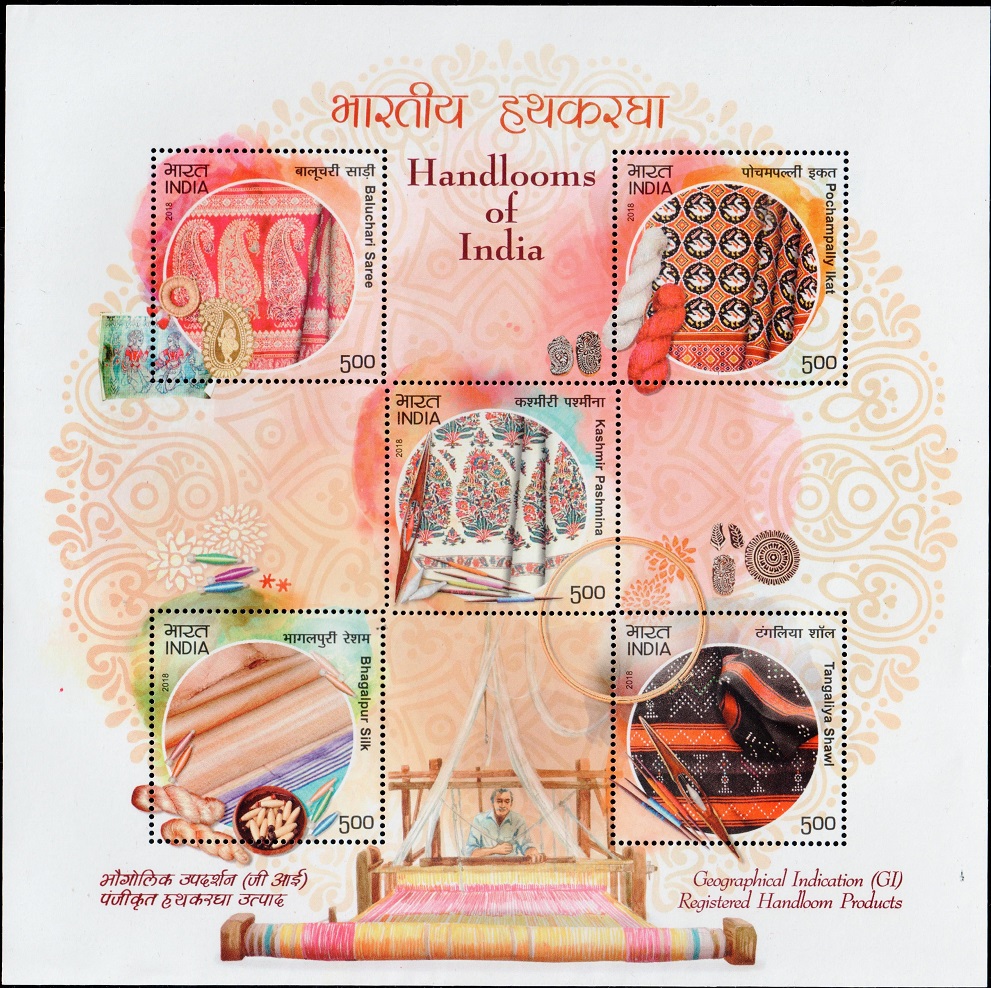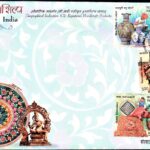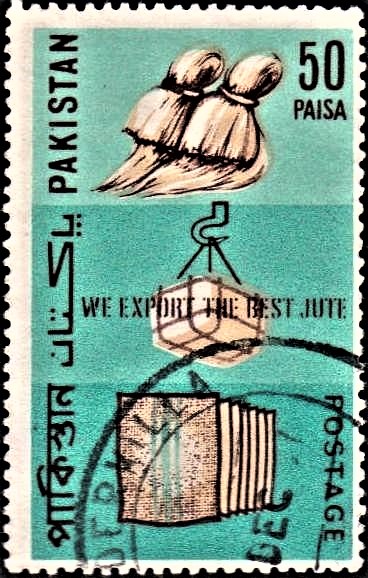
Handlooms of India 2018
Complete set of 5 nos. of commemorative postage stamps on Geographical Indication (GI) Registered Handloom Products : Baluchari Saree, Bhagalpur Silk, Kashmir Pashmina, Pochampally Ikat and Tangaliya Shawl :





 Issued by India
Issued by India
Issued on Aug 7, 2018
Issued for : Department of Posts is pleased to issue a set of five Commemorative Postage Stamps on GI Registered Handloom Products.
Credits :
Stamps/Miniature Sheet/FDC/Brochure : Shri Kamleshwar Singh
Cancellation Cachet : Smt. Alka Sharma
Type : Miniature Sheet, Mint Condition
Colour : Multi Colour
Denomination : 500 Paise (5)
Stamps Printed : 606000 each
Miniature Sheets Printed : 110950
Printing Process : Wet Offset
Printer : Security Printing Press, Hyderabad
About :
- A Geographical Indication (GI) is a name or sign used on certain products which corresponds to a specific geographical location or origin (e.g. a town, region, or country). India, as a member of the World Trade Organization (WTO), enacted the Geographical Indication of Goods (Registration and Protection) Act, 1999 with effect from 15 September, 2003. The GI tag ensures that none other than those registered as authorised users (or at least those residing inside the geographic territory) are allowed to use the popular product name. Darjeeling tea became the first GI tagged product in India in 2004-05. By May 2017, 295 other GI tagged products have been added to the list.
- Department of Posts is releasing a set of Commemorative Postage Stamps on GI Registered Handloom Products as follows:
- Baluchari Saree: Baluchari is an exquisite silk saree of West Bengal produced by highly skilled weavers having generations of experience in handloom weaving. The name Baluchari is derived from the word “Baluchar” an area comprising several villages in the district of Murshidabad. In the middle of the 16th century, a group of experienced weavers from Varanasi migrated to Bengal and settled in Baluchar. They were famous for their weaving skill. They made beautiful designs on silk fabrics mainly used as sarees and exclusively patronized by the Nawabs and aristocrats of the society.
- Bhagalpur Silk: Bhagalpur is a town of historical importance situated on the southern bank of the Ganga River. Bhagalpur is globally renowned for manufacturing quality silk fabrics and sarees. Presently, Bhagalpur is an important centre for producing Mulberry, Tasar, Eri silks, cotton and their blends. The types of yarn developed from Tasar cocoon are Reeled Tasar, Katiya, Gichha and Balkal yarn etc. Similarly, various qualities of mulberry silk yarn are Reeled, Spun, Dupion, Noil, Matka etc. These are used extensively to develop variety of textiles and products.
- Kashmir Pashmina: Pashmina was first made by inhabitants of Kashmir. The quest for making a fine warm fabric to protect them from the harsh winter created Pashmina when they discovered an animal that produced one of the warmest raw materials called Pashm, the name given to the fleece of Changthangi goat (capra hiracus). The best Kashmiri shawls produced today are made from the soft, downy undercoat that grows primarily on the neck and belly of the Himalayan mountain goat, ‘capra hiracus’.
- Pochampally Ikat: Pochampally Ikat is a saree made in Bhoodan Pochampally, Yadadri Bhuvanagiri district, Telangana. Pochampally Ikat or resist dyeing involves the sequence of tying and dyeing sections and bunches of yarn to a predetermined color scheme prior to weaving. Thus the dye penetrates into the exposed section of the yarn while the tied section remains un-dyed. The patterns formed by this process on the yarn are then woven into fabric.
- Tangaliya Shawl: Tangaliya Shawl is a distinct handloom weaving tradition. It consists of rolling a lump of fibres of a contrast color thread along the warp as per design and pushing them together to create the effect of raised dots on the surface of the fabric. Tangaliya is an age-old weaving craft which evolved in the Saurashtra region of Gujarat around 700 years ago. It is produced in some parts of the Kutch as well as Junagarh and Surendranagar districts of Gujarat.
- Text : Based on information received from Ministry of Textiles.
Subscribe
Login
0 Comments
Oldest







